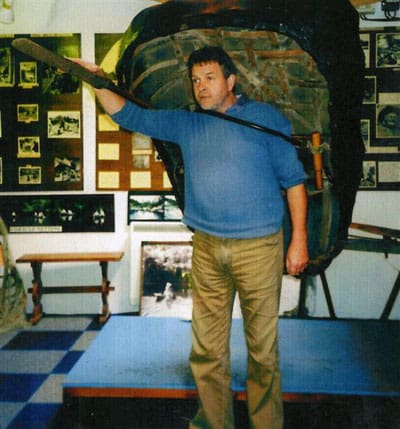
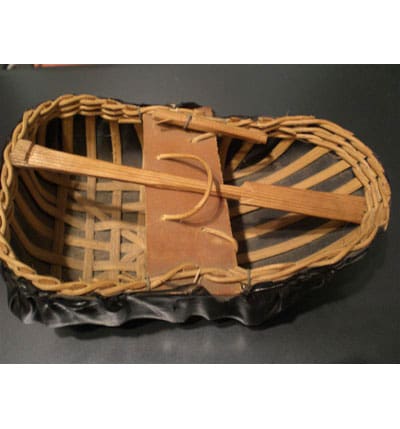
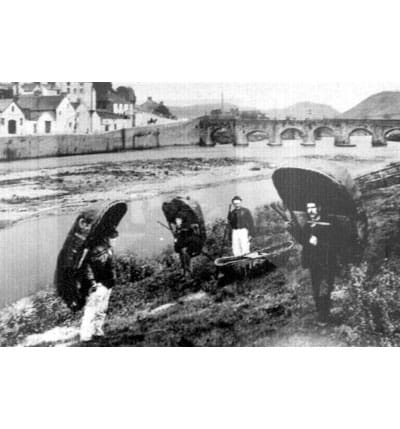
Pic 1: Martin Fowler shows the correct way to carry a Teifi Coracle. Pic 2: This attractive coracle model employs authentic construction methods and a number of laths and measures only 7ins x 4.5ins. Pic 3: An archive black and white photograph of coracles in use on the Towy at Carmarthen.
A Welsh comedy series of the 1990s had a running sketch involving a coracle owner. Each week, a genuine interview with a fisherman was interspersed with ever more ludicrous questions. The man was asked for example, why he was trying to race Concorde across the Atlantic or paddle his coracle to Mars. The earnest Welshman’s answer to each poser was invariably, It’s been done before, but it’s a challenge! You may be unlikely to achieve warp drive in a coracle, but the boat can be remarkably versatile, as a visit to the National Coracle Centre at Cenarth on the Teifi will prove. The museum is in the grounds of a 17th century flour mill beside the beautiful falls on the Teifi famed for its salmon leaps and 200 year old bridge over the river. The museum, apart from its fine collection of coracles covers their history and the techniques and tools for building them. Also there is a section on the implements and methods used for the equally ancient art of poaching. This privately run and self funded museum is run by Martin Fowler, himself a coracle fisherman.
Design and use
As far as boat designs go, the original coracle is about one stage beyond the hollowed-out log. Consisting of a wooden frame with an animal skin stretched across it forming the hull, together with a single seat and a paddle, and that’s your lot. They first made their appearance during the last Ice Age around 8,000 years ago and have been in use ever since. Coracles are associated commonly with Welsh rivers and those in Scotland and Ireland, where the craft are known as Curraghs. Yet, in various guises, the work craft hale from several continents. Those in the British Isles are provided with a seat, those elsewhere are seatless and some like the Indian Parisal, are steered from a standing position. Typically home countries coracles weigh between 20 to 40lbs and can be carried by the fisherman in a variety of ways, sometimes slung across the back – ideal if you need to walk some way to the place where you fish.
Enjoy more Model Boats Magazine reading in the monthly magazine.
Click here to subscribe & save.
The Cenarth Collection
This has the world’s finest display of coracles from as far afield as Vietnam, where bamboo woven examples were once used to lay explosive mines, Iraq with the so-called Guffa which plies rivers packed to the gunwales with water melons and the native American Bull Boat. This, the last listed, uses for its covering a bison hide with the hair to the outside and the tail left on, so as to streamline the craft and aid waterproofing. The tail also acts as a useful mooring device. The Vietnamese version on show was rescued from being scrapped by the curator of the former boat museum in Exeter. It once carried a family of boat people to safety across the South China Sea. The Cenarth Centre takes you through the construction of a typical Welsh coracle, although size and design varies between the three West Walian rivers on which they are used for fishing, the Towy, Teifi and Taf. In Wales they are single person boats, which fish in pairs and there are about a dozen coracle fishing licences on the Teifi.
Construction and operation
The making of a typical Teifi coracle starts with the winter gathering of willow which is sapless. The willow is split and shaved into wooden strips or laths to form the framework. Seven are placed lengthwise and ten across, with two across the centre. The final structure is then soaked to make the wood supple and workable. The laths are woven together using triple rows of finger thick hazel. As the frame needs to be flat bottomed, it is again soaked, then inverted and a weight placed over the structure. When dry, the framework is covered with calico covered in waterproof pitch. Even in Wales, coracle shapes differ, ranging from almost round to kidney shaped and to almost square. Try to paddle a coracle like a canoe and you will quickly go round in circles. A common paddling technique is to use a figure of eight motion over the bow. A 20ft by 3 1/2ft deep net is held between a pair of coracles in mid-stream, until a fish enters the net and is hauled aboard. The principal skill that is required, is to keep the boats on station and level with one another.
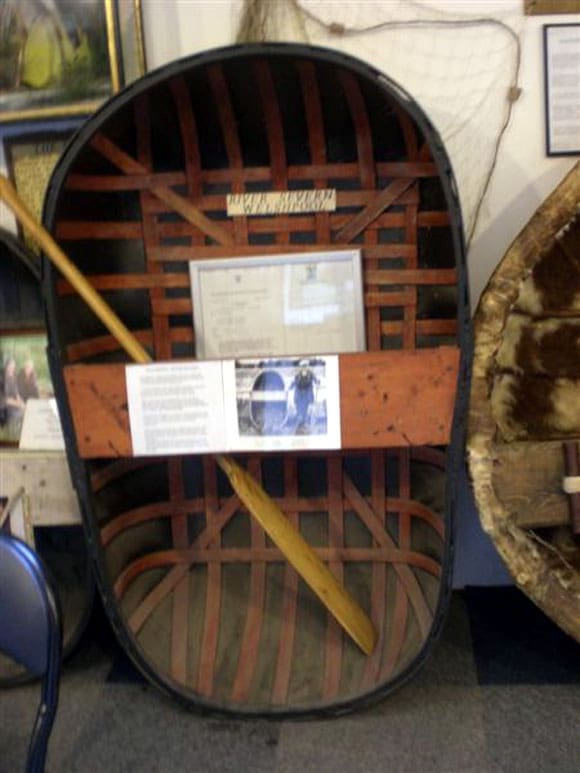
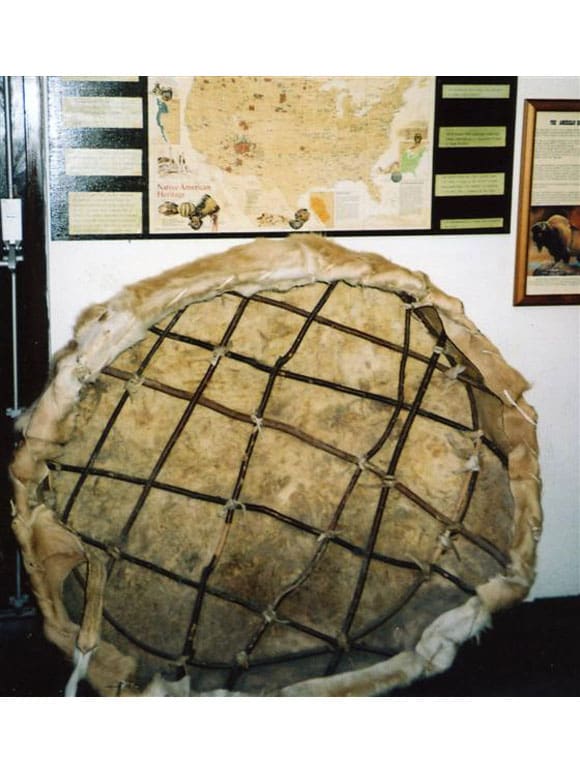
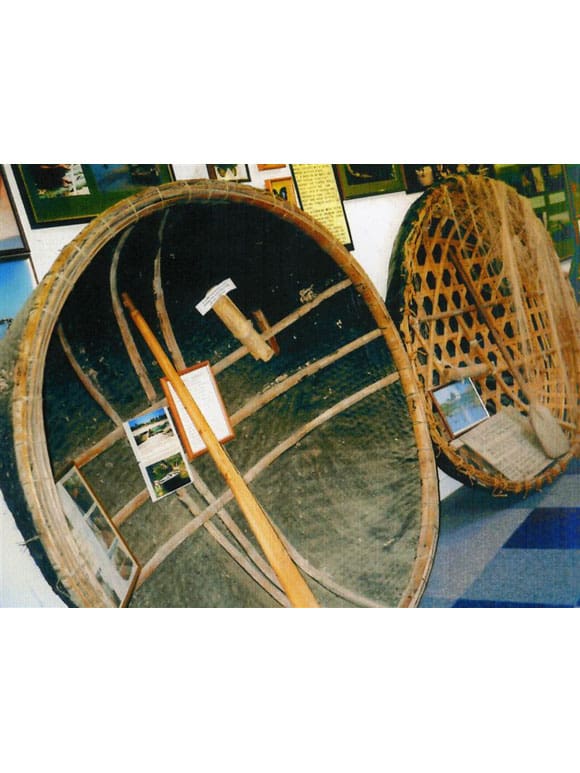
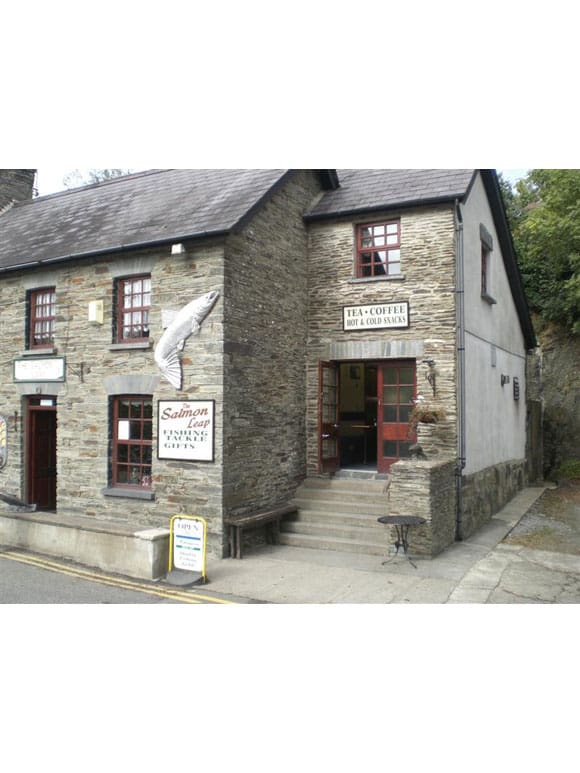
Pic 4: A coracle from the River Severn. Pic 5: A bull boat clearly showing the tail of the hide in place. Pic 6: At the front is an Iraqi Guffa and behind it is an Indian Parisal. Pic 7: The flour mill besides the falls on the Teifi, famed for their salmon leaps.
The Mill at Cenarth and a bit of history
Here, where the Coracle Centre is housed there is a surprise – lift a floor slab and you have access to the river for some handy poaching. A former miller exploited this feature to catch salmon and sewin (sea trout). The spoilsport river authorities circumvented this bit of local enterprise by placing a grill over the entrance to the mill race.
Surprisingly, coracles are largely absent from mainland Europe. In 1912, coracles hit the headlines when the Morgan brothers used theirs to explore a network of caves at the head of the Swansea Valley. Cenarth’s Martin Fowler was enlisted by television to re-enact the event, an acting tour-de-force which imperiled his life through an inflammable false moustache. Ask Martin, or buy the centre brochure for the full story. Today, Dan-yr-Ogof is home to the National Show Caves of Wales and to a dinosaur park. Coracles are also built at several points on the River Severn and one such craft was put to remarkable sporting use. A Shrewsbury resident performed a valuable service using his coracle, retrieving footballs booted out of Shrewsbury’s old Gay Meadow Ground into the river. Most coracle makers stick to tried and tested methods, but shock, horror, some craft now have hulls of GRP! That’s what they call progress..
Useful information
The National Coracle Centre is at Cenarth Falls, near Newcastle Emlyn, Carmarthenshire, Wales, SA38 9JL. Tel: 01239 710980/710507 or www.coracle-centre.co.uk. Email martin.cenarthmill@virgin.net. It is open daily, from Easter to the end of October, 10.30am to 5.30pm. Check opening hours for the winter months. There is an excellent guidebook with archive photographs, including one remarkable image from Ireland showing a basking shark, being trapped by a coracle.




